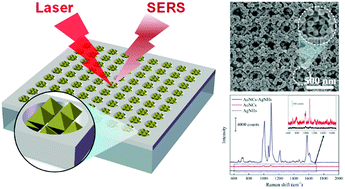Surface enhanced Raman scattering (SERS) substrates with excellent enhancement and reproducibility have seen continuous research in recent years. Herein, we report a high performance hybrid SERS substrate which is composed of octahedral Au nanocrystals (AuNCs) and Ag nanohole (AgNH) arrays to achieve both high enhancement and reproducibility. The octahedral AuNCs were prepared by controllable chemical synthesis and the AgNHs over 5 × 5 mm2 in area were fabricated by a surface plasmon lithography (SPL) technique. The hybrid structure was prepared by self-assembly of the colloidal AuNCs onto the AgNHs. The SERS substrate shows an enhancement factor (EF) of 3.6 × 106, which is much higher than that of either the AuNCs or AgNHs. The high SERS enhancement is ascribed to the high-density hotspots with a 3-dimensional (3D) distribution and the effect of plasmonic coupling from these hybrid structures. In addition, the substrate shows excellent reproducibility and stability. The relative standard deviation (RSD) is less than 7% and the SERS intensity only decreases by 32% after 100 days of exposure to air. It is expected that the designed hybrid structure of AuNCs and AgNHs with excellent SERS performance is a potential candidate for applications, such as in food safety, disease diagnosis, environmental monitoring and other practical trace detection.
